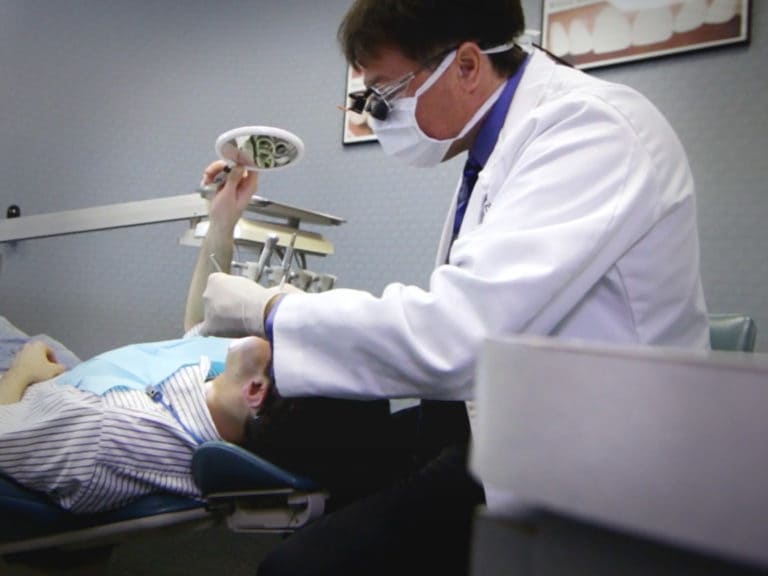How dentists can bring in more dental patients without feeling like a used car salesperson
Within a few weeks of moving to Phoenix, and well before I’d even heard of the Arizona Dental Association, I jumped on the teeth-whitening band wagon and visited a dental office in the Biltmore area. After fifteen minutes of paperwork and an hour in the operatory, I headed home with a brighter, whiter smile. Despite having mouth full of sensitive teeth, I was delighted with the procedure, as well as the dentist’s gentle demeanor. However, I never went back.
Think about that for a moment. I had no dental home; I was new in town; I had a great experience; I even liked the dentist, and yet, I never went back. Why?
I was never asked.
I didn’t go into this dentist’s office thinking, “If I like the doctor and their team, this could be my new dental home.” I was there to get my teeth whitened—nothing else. However, like many other one-time patients (including emergency patients), my focus was on an immediate need, but that doesn’t mean that I would have been opposed to becoming a regular patient. The truth is, you can convert one-time patients into regular patients if you follow a system (provided below)—if you address the patient’s immediate need, and then you tactfully ask the patient at the appropriate time.
To be fair, maybe the practice wasn’t looking for new patients when I came in, or maybe I wasn’t a fit for their patient base. However, I do know that patients, like money, don’t grow on trees. With that in mind, we’ll look at an approach you can take to convert one-and-done people into patients who are happy to return for regular checkups and treatment. Keep in mind that this is just one approach. If the approach below doesn’t feel right to you, feel free to modify it so it suits your personality.
Get ‘em while you got ‘em approach to retaining your dental patients
Whether you’re talking with someone associated with sales at a fitness club, chiropractor’s office, or marketing firm, she’ll tell you that if the consumer walks out of your office without an agreement to return, the likelihood the consumer comes back plummets. Admittedly, sales and dentistry are like mixing oil and water, but if building your patient base is a priority—you’ll need to embrace sales. You’ll want to make it a priority to ask the one-time patient/person if he might be open to becoming a patient before he’s left the office.
Dentists wince at the idea of incorporating any sales into their practice—many are probably wincing after reading the previous paragraph.
However, if a dentist really believed she could improve the oral and systemic health of the people who come into her office, why would she be opposed to asking a person if coming back in for treatment would be desirable? No matter what your profession, if you truly believe in the value of service you provide, why should you avoid asking patients/customers/consumers if they want it? Contrary to popular belief in the healthcare profession, “sales” does not have to be a dirty word, and sales can be done with honesty, tact, and professionalism.
Build your patient base in your dental practice without feeling like a used car salesperson
- Note the appointment times of first-time patients before the day begins.
- Make certain your dental team takes extra time and care in dealing with these people. It’s important these patients feel at home from the moment they walk in the door.
- Each member of the dental team who interacts with the patient should reassure the patient that the team and the doctor are focused on attending to their immediate need.
- While their oral health might need attention, attend to or treat their immediate need first. If you shift the focus of the appointment before you address their immediate need, your patient may feel you don’t listen or that you’re just out for more money. For example, “I know you came in today to have your teeth whitened, Michael. However, we’ll need to talk about a couple of problems I can see between your central and lateral incisors.” We both recognize that you’re looking after the patient by caring for their overall oral health, but your patient’s perception might be that you’re looking to just make more money rather than attending to their need.1
- After the procedure or treatment, let the patient know you attended to their need and that they’re in better shape than when they came in. For example, “Okay, Joan, we’ve gone ahead and extracted that third molar that was giving you so much trouble. You may feel a little discomfort that will subside after a couple of days, but the grinding sensation you were having—well, we’ve taken care of it, so you should be in great shape.”
- Verify the patient is pleased and/or that they’ve had a good experience. While it might be tempting, do not skip this step.
If the person isn’t pleased or hasn’t had a good experience, he will not entertain the idea of becoming a regular patient of yours.
After the treatment, ask the patient how they’re feeling. If they are in pain, focus on asking how they’ll feel about having their need addressed. For example, “I know that tooth is going to be sensitive for a few hours. How does it feel? I remember it was causing you so much pain when you came in, but you’ll be as good as new tomorrow—how does that sound?” If the patient is in pain, skip step 7. - Ask the patient if there’s anything else that might be causing them trouble, or perhaps something they were thinking they’d like to have done. For example, “I am glad we were able to treat that cavity before it really started to bother you—it was great to meet you. [PAUSE] It’s up to you, but if I am able to get a look at your teeth a couple of times during the year, we’ll be able to spot any troubles quickly so they don’t turn into bigger problems. Is that something you’d like to do?” *
- Ask permission to follow up, which gives you another opportunity to connect with the person (possibly getting them to see the value of being a patient). After the patient responds to the question in #7, ask if he would be open to you checking up on him within the next 24 hours to make sure he’s doing okay. For example, “It looks you’re going to be in good shape, but I just want to follow up with you and make sure you’re doing great and that you don’t have any questions. Would that be okay?” *
- During the follow up call (whoever makes it), ask the patient how he is doing and if he has any questions or concerns. If he has agreed to come back in, indicate that you see on the schedule he’ll be coming back in on DATE and TIME. Tell them, “That’s great. We’ll look forward to seeing you again.”
If the person is not feeling fine, attend to that need immediately. If the person is feeling fine but they didn’t agree to come back in for treatment, ask, “I am so glad you’re feeling better—we enjoyed having you visit! So we make sure we’re on top of things well before they cause you any discomfort, would you be open to coming back in and seeing us in SPECIFIC MONTH? - If the patient has indicated he had relatively good experience in your office but still hasn’t agreed to come in for treatment after asking him twice, make sure you periodically send him a marketing/promotional postcard or follow up email every couple of months. Keep this practice up for a year or until he’s scheduled an appointment. If after a year the person has not scheduled an appointment, send him a letter indicating that you’d still love to see him and that it’s not too late. Let him know you wish him the best and that you genuinely hope he establishes a dental home.
1 NOTE: Of course there are instances when attending to your patient’s perceived need is not as important as another oral health issue you’ve diagnosed. In these cases, you’ll need to gently inform the patient what you’ve discovered, as well as help them understand that having the issue you found treated will benefit them.
* Some dental offices are set up to have the hygienist, dental assistant, or even the front office person ask or engage the patient in this area. From a logistical standpoint, this might be ideal. However, from a sales or effectiveness standpoint, it would be best if the doctor asked the patient these questions. Yes, dentists are terribly busy, but five extra minutes might be the difference between a new patient and a person you’ll never see again. You make the call if it’s worth it.
Common mistakes dentists make using this sales approach to getting more patients
- Dentists and or their team ask people to become patients before they’ve attended to the immediate need, or before they’ve verified the patient has had a pleasant experience.
- The dentist or a dental team member awkwardly blurts out, “Hey, maybe you could consider being one of our patients,” which puts the people in an uncomfortable situation.
- The dentist or dental team members are too aggressive or overzealous. Conversely, some doctors and teams lack the self-assuredness to confidently ask “one-timers” if they would consider coming in for regular treatment. The key to increasing your odds for success is finding a balance.
- It is an inappropriate time to ask the patient, e.g., patient is in notable pain; patient is in a bad mood; patient is overly rushed or distracted; patient appears not to be satisfied.

